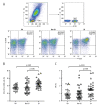Circulating Angiogenic T Cells Are Increased in Lupus Nephritis Patients
- PMID: 30072685
- PMCID: PMC6087034
- DOI: 10.12659/MSM.908406
Circulating Angiogenic T Cells Are Increased in Lupus Nephritis Patients
Abstract
BACKGROUND Patients with systemic lupus erythematosus (SLE), especially with lupus nephritis (LN), undergo vascular damage and repair during the course of the disease. Since the recently identified angiogenic T cells (Tang) are involved in endothelial repair coupled with endothelial progenitor cells (EPCs), this study investigated the circulating Tang cells in LN patients and their potential correlations with disease features. MATERIAL AND METHODS Circulating Tang cells and EPCs were assessed by flow cytometry in peripheral blood samples from 67 SLE patients; of these, 32 had LN and 30 were matched healthy controls (HCs). The plasma levels of interleukin IL-17, IL-8, and vascular endothelial growth factor (VEGF) were quantified by immunoassays. RESULTS The percentage of circulating Tang cells in LN patients was significantly increased as compared to the non-LN patients and HCs, and they were positively correlated with the level of EPC and VEGF. Additionally, circulating Tang cell percentages were positively correlated with the extent of proteinuria in LN patients. CONCLUSIONS The increased levels of circulating Tang cells in LN patients might play a role in the balance of endothelium dysfunction in these patients.
Conflict of interest statement
None.
Figures


Similar articles
-
The IMMENSE Study: The Interplay Between iMMune and ENdothelial Cells in Mediating Cardiovascular Risk in Systemic Lupus Erythematosus.Front Immunol. 2020 Oct 29;11:572876. doi: 10.3389/fimmu.2020.572876. eCollection 2020. Front Immunol. 2020. PMID: 33193356 Free PMC article.
-
Interleukin-10 receptor expression and signalling were down-regulated in CD4⁺ T cells of lupus nephritis patients.Clin Exp Immunol. 2011 Aug;165(2):163-71. doi: 10.1111/j.1365-2249.2011.04424.x. Epub 2011 Jun 2. Clin Exp Immunol. 2011. PMID: 21635228 Free PMC article.
-
Circulating Angiogenic T Cells and Their Subpopulations in Patients with Systemic Lupus Erythematosus.Mediators Inflamm. 2016;2016:2842143. doi: 10.1155/2016/2842143. Epub 2016 Mar 15. Mediators Inflamm. 2016. PMID: 27065298 Free PMC article.
-
T cells and IL-17 in lupus nephritis.Clin Immunol. 2017 Dec;185:95-99. doi: 10.1016/j.clim.2016.04.010. Epub 2016 Apr 21. Clin Immunol. 2017. PMID: 27109641 Free PMC article. Review.
-
B Cell Abnormalities in Systemic Lupus Erythematosus and Lupus Nephritis-Role in Pathogenesis and Effect of Immunosuppressive Treatments.Int J Mol Sci. 2019 Dec 10;20(24):6231. doi: 10.3390/ijms20246231. Int J Mol Sci. 2019. PMID: 31835612 Free PMC article. Review.
Cited by
-
IFN-I Mediates Dysfunction of Endothelial Progenitor Cells in Atherosclerosis of Systemic Lupus Erythematosus.Front Immunol. 2020 Nov 11;11:581385. doi: 10.3389/fimmu.2020.581385. eCollection 2020. Front Immunol. 2020. PMID: 33262760 Free PMC article. Review.
-
Angiogenic T cells are decreased in people with type 2 diabetes mellitus and recruited by the dipeptidyl peptidase-4 inhibitor Linagliptin: A subanalysis from a randomized, placebo-controlled trial (RELEASE study).Diabetes Obes Metab. 2020 Jul;22(7):1220-1225. doi: 10.1111/dom.14024. Epub 2020 Mar 27. Diabetes Obes Metab. 2020. PMID: 32166899 Free PMC article. Clinical Trial.
-
Immune mechanisms associated with cardiovascular disease in systemic lupus erythematosus: A path to potential biomarkers.Front Immunol. 2022 Nov 7;13:974826. doi: 10.3389/fimmu.2022.974826. eCollection 2022. Front Immunol. 2022. PMID: 36420265 Free PMC article. Review.
-
Angiogenic T Cells: Potential Biomarkers for the Early Diagnosis of Interstitial Lung Disease in Autoimmune Diseases?Biomedicines. 2022 Apr 5;10(4):851. doi: 10.3390/biomedicines10040851. Biomedicines. 2022. PMID: 35453601 Free PMC article.
-
The vascular endothelial growth factor as a candidate biomarker of systemic lupus erythematosus: a GRADE-assessed systematic review and meta-analysis.Clin Exp Med. 2024 Sep 11;24(1):218. doi: 10.1007/s10238-024-01487-w. Clin Exp Med. 2024. PMID: 39259392 Free PMC article.
References
-
- Gorman C, Isenberg D. Atherosclerosis and lupus. Rheumatology (Oxford) 2004;43:943–45. - PubMed
-
- Esdaile JM, Abrahamowicz M, Grodzicky T, et al. Traditional Framingham risk factors fail to fully account for accelerated atherosclerosis in systemic lupus erythematosus. Arthritis Rheum. 2001;44:2331–37. - PubMed
-
- Hur J, Yang HM, Yoon CH, et al. Identification of a novel role of T cells in postnatal vasculogenesis: Characterization of endothelial progenitor cell colonies. Circulation. 2007;116:1671–82. - PubMed
-
- Asahara T, Murohara T, Sullivan A, et al. Isolation of putative progenitor endothelial cells for angiogenesis. Science. 1997;275:964–67. - PubMed
Publication types
MeSH terms
Substances
LinkOut - more resources
Full Text Sources
Other Literature Sources

